Side-stream respiratory gas monitoring system and method
a technology of respiratory gas and monitoring system, which is applied in the direction of valve operating means/release devices, applications, diagnostic recording/measuring, etc., can solve the problems of inaccurate interpretation of respiration performance, affecting the accuracy of information acquired and any conclusions, and affecting the timeliness of respiration performance determination, etc., to achieve simple and efficient manufacturing and operation.
- Summary
- Abstract
- Description
- Claims
- Application Information
AI Technical Summary
Benefits of technology
Problems solved by technology
Method used
Image
Examples
Embodiment Construction
[0048]FIG. 2 shows a monitoring system 30 according to the present invention. Monitoring system 30 includes a control or analyzer 32, a sensor 34, and a display 36. Sensor 34 is constructed to engage a respiration flow, indicated by arrow 38, or a participant or patient 40. A number of tubes 42 operatively connect sensor 34 to analyzer 32. A first and a second tube 44, 46 are connected to sensor 34 to detect a pressure differential of respiration flow 38 in sensor 34. A third tube 48 acquires an aspirated sample of respiration flow 38 and communicates the sample to analyzer 32. A physiological detector, preferably a heart rate monitor 50, is also connected to analyzer 32 and constructed to communicate a patient cardiac status to analyzer 32. Preferably, monitor 50 is configured to monitor both the pulsatile effects of the patient's cardiac cycle as well as the saturated oxygen content of the patient's circulation system.
[0049]Analyzer 32, having acquired the data or signals from tub...
PUM
 Login to View More
Login to View More Abstract
Description
Claims
Application Information
 Login to View More
Login to View More - R&D
- Intellectual Property
- Life Sciences
- Materials
- Tech Scout
- Unparalleled Data Quality
- Higher Quality Content
- 60% Fewer Hallucinations
Browse by: Latest US Patents, China's latest patents, Technical Efficacy Thesaurus, Application Domain, Technology Topic, Popular Technical Reports.
© 2025 PatSnap. All rights reserved.Legal|Privacy policy|Modern Slavery Act Transparency Statement|Sitemap|About US| Contact US: help@patsnap.com



